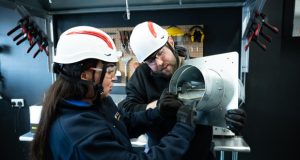Experts are warning that healthcare workers who wash their uniforms at home may be compromising the safety of not only their family but also their colleagues and patients.
Public Health England (PHE) recommends uniforms are washed in commercial laundries, but it is not compulsory. Furthermore, it says that domestic washing should be adequate. However, this is based on reviews published in 2007 – and flies in the face of more recent publications, which argue that domestic washers are not a sufficient way to decontaminate healthcare laundry.
For example, PHE says that washing with detergents at 30ºC will remove most Gram-positive micro-organisms and that washing at 60ºC is sufficient to remove almost all micro-organisms. But domestic washing machines are designed to aesthetically clean laundry and not to disinfect and generally do not hold the selected temperature once it has been reached. Tests comparing bacteriological disinfection between an industrial laundry process at 65°C and a domestic process at 60°C indicate that the domestic machine will leave more than one thousand times the number of viable (live) bacteria than its industrial counterpart.
Most research to date has looked at bacterial disinfection in the laundry process and there is an urgent requirement to repeat this work for viruses. However, a recent scientific paper reports that SARS-CoV-2 survived at 37°C for 24 hours and 10 minutes at 56°C.
David Stevens is CEO of the Textiles Services Association (TSA), which represents commercial laundries in the UK, he said: “Tests have shown that most washing machines used in home settings, whenl oaded and set on a 60°C wash program, do not actually reach 60°C. Furthermore, they do not have the controls to maintain the temperature long enough to achieve the disinfection parameters that the research would suggest are required. Industrial laundries not only achieve the temperature, they also have a much more efficient mechanical wash than domestic machines. We believe that, just as has been proven with bacteria, an industrial laundry is likely to be at least 1000 times more effective at killing the SARS-CoV-2 virus than a domestic washing machine.”
Dr Katie Laird of De Montfort University (DMU) has conducted extensive research on the survival of microorganisms through both domestic and industrial wash processes. She commented: “Healthcare worker uniforms are commonly laundered at home in the UK, unlike in the rest of Europe where uniforms are either washed within the hospital or at an industrial laundry. The DMU work highlights some of the potential dangers of washing uniforms at home. They include contamination of the home environment; transmission to others in the home setting; inadequate decontamination of healthcare uniforms and transfer to other items of clothing in the wash; and the potential for transmission back into the hospital environment via the home washed healthcare uniforms.”
When it comes to best practice for health workers who are laundering their uniforms at home, PHE says that they should transport the uniform in a disposable plastic bag. Clothing should be washed at the highest temperature it can tolerate, in a separate half load, and it should be ironed or tumble dried. Previous research by Dr Laird found that healthcare workers were not always adhering to these policies when laundering at home, leading to the risk of inadequate decontamination. It showed 44 per cent of workers were laundering their uniforms at temperatures below 60°C, and 40% laundered them with other clothing items.
Stevens points out that there are 24,000 laundry workers who have been furloughed due to the crisis, as they worked for laundries servicing the hospitality sector. “The UK laundry industry has the capacity to cope with the extra demand of washing healthcare workers uniforms,” he says. “Closed laundries can be reopened and repurposed for the healthcare sector. They already have the appropriate processes in place to ensure that the job is done safely and efficiently. We should not be asking healthcare workers to take potentially contaminated uniforms for home washing. The laundry industry stands ready to play its part in fighting this terrible disease.”





